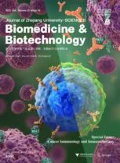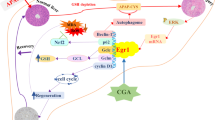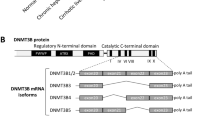Abstract
Background and objective: Liver regeneration is a complex process regulated by a group of genetic and epigenetic factors. A variety of genetic factors have been reported, whereas few investigations have focused on epigenetic regulation during liver regeneration. In the present study, valproic acid (VPA), a histone deacetylase (HDAC) inhibitor, was used to investigate the effect of HDAC on liver regeneration. Methods: VPA was administered via intraperitoneal injection to 2/3 partially hepatectomized mice to detect hepatocyte proliferation during liver regeneration. The mice were sacrificed, and their liver tissues were harvested at sequential time points from 0 to 168 h after treatment. DNA synthesis was detected via a BrdU assay, and cell proliferation was tested using Ki-67. The expressions of cyclin D1, cyclin E, cyclin dependent kinase 2 (CDK2), and CDK4 were detected by Western blot analysis. Chromatin immunoprecipitation (ChIP) assay was used to examine the recruitment of HDACs to the target promoter regions and the expression of the target gene was detected by Western blot. Results: Immunohistochemical analysis showed that cells positive for BrdU and Ki-67 decreased, and the peak of BrdU was delayed in the VPA-administered mice. Consistently, cyclin D1 expression was also delayed. We identified B-myc as a target gene of HDACs by complementary DNA (cDNA) microarray. The expression of B-myc increased in the VPA-administered mice after hepatectomy (PH). The ChIP assay confirmed the presence of HDACs at the B-myc promoter. Conclusions: HDAC activities are essential for liver regeneration. Inhibiting HDAC activities delays liver regeneration and induces liver cell cycle arrest, thereby causing an anti-proliferative effect on liver regeneration.
Similar content being viewed by others
References
Asker, C., Magnusson, K.P., Piccoli, S.P., Andersson, K., Klein, G., Cole, M.D., Wiman, K.G., 1995. Mouse and rat B-myc share amino acid sequence homology with the C-myc transcriptional activator domain and contain a B-myc specific carboxyl terminal region. Oncogene, 11(10):1963–1969.
Awad, M.M., Gruppuso, P.A., 2000. Cell cycle control during liver development in the rat: evidence indicating a role for cyclin D1 posttranscriptional regulation 1. Cell Growth Differ., 11(6):325–334.
Bartolini, G., Orlandi, M., Papi, A., Ammar, K., Tonelli, R., Franzoni, M., Pession, A., Rocchi, P., Ferreri, A.M., 2008. Growth inhibition and proapoptotic activity induction by I IF and valproic acid on RA-resistant leukemia cells. Anticancer Res., 28(1A):283–288.
Burton, R.A., Mattila, S., Taparowsky, E.J., Post, C.B., 2006. B-myc: N-terminal recognition of myc binding proteins. Biochemistry, 45(32):9857–9865. [doi:10.1021/bi060379n]
Cheng, M., Sexl, V., Sherr, C.J., Roussel, M.F., 1998. Assembly of cyclin D-dependent kinase and titration of p27Kip1 regulated by mitogen-activated protein kinase kinase (MEK1). PNAS, 95(3):1091–1096. [doi:10.1073/pnas.95.3.1091]
Cheng, X., Blumenthal, R.M., 2011. Introduction-epiphanies in epigenetics. Prog. Mol. Biol. Transl. Sci., 101:1–21. [doi:10.1016/B978-0-12-387685-0.00001-9]
Cornwall, G.A., Collis, R., Xiao, Q., Hsia, N., Hann, S.R., 2001. B-myc, a proximal caput epididymal protein, is dependent on androgens and testicular factors for expression. Biol. Reprod., 64(6):1600–1607. [doi:10.1095/biolreprod64.6.1600]
Facchini, L.M., Penn, L.Z., 1998. The molecular role of myc in growth and transformation: recent discoveries lead to new insights. FASEB J., 12(9):633–651.
Fausto, N., 2000. Liver regeneration. J. Hepatol., 32(1 Suppl.): 19–31. [doi:10.1016/S0168-8278(00)80412-2]
Fujiyoshi, M., Ozaki, M., 2011. Molecular mechanisms of liver regeneration and protection for treatment of liver dysfunction and diseases. J. Hepatobilliary Pancreat. Sci., 18(1):13–22. [doi:10.1007/s00534-010-0304-2]
Gregory, M.A., Xiao, Q., Cornwall, G.A., Lutterbach, B., Hann, S.R., 2000. B-myc is preferentially expressed in hormonally-controlled tissues and inhibits cellular proliferation. Oncogene, 19(42):4886–4895. [doi:10.1038/sj.onc.1203851]
Gurvich, N., Tsygankova, O.M., Meinkoth, J.L., Klein, P.S., 2004. Histone deacetylase is a target of valproic acid-mediated cellular differentiation. Cancer Res., 64(3):1079–1086. [doi:10.1158/0008-5472.CAN-03-0799]
Higgins, G.M., Anderson, R.M., 1931. Experimental pathology of the liver: restoration of the liver of the white rat following partial surgical removal. Arch. Pathol., 12:186–202.
Ingvarsson, S., Asker, C., Acelson, H., Klein, G., Sumegi, J., 1988. Structure and expression of B-myc, a new member of the myc gene family. Mol. Cell. Biol., 8(8):3168–3174. [doi:10.1128/MCB.8.8.3168]
Kaiser, M., Zavrski, I., Sterz, J., Jakob, C., Fleissner, C., Kloetzel, P.M., Sezer, O., Heider, U., 2006. The effects of the histone deacetylase inhibitor valproic acid on cell cycle, growth suppression and apoptosis in multiple myeloma. Haematologica, 91(2):248–251.
Katsuyama, T., Paro, R., 2011. Epigenetic reprogramming during tissue regeneration. FEBS Lett., 585(11):1617–1624. [doi:10.1016/j.febslet.2011.05.010]
Ke, Q., Erbolat, Zhang, H.Y., Bu, H., Li, S., Shi, D.N., Yang, G.H., Chen, H.J., Wei, B., 2007. Clinicopathologic features of pleomorphic hyalinizing angiectatic tumor of soft parts. Chin. Med. J., 120(10):876–881.
Martín-Subero, J.I., Esteller, M., 2011. Profiling epigenetic alterations in disease. Adv. Exp. Med. Biol., 711:162–177. [doi:10.1007/978-1-4419-8216-2_12]
Merion, R.M., 2010. Current status and future of liver transplantation. Semin. Liver Dis., 30(4):411–421. [doi:10.1055/s-0030-1267541]
Michaelis, M., Michaelis, U.R., Fleming, I., Suhan, T., Cinatl, J., Blaheta, R.A., Hoffmann, K., Kotchetkov, R., Busse, R., Nau, H., et al., 2004. Valproic acid inhibits angiogenesis in vitro and in vivo. Mol. Pharmacol., 65(3): 520–527. [doi:10.1124/mol.65.3.520]
Mitchell, C., Willenbring, H., 2008. A reproducible and well-tolerated method for 2/3 partial hepatectomy in mice. Nat. Protoc., 3(7):1167–1170. [doi:10.1038/nprot.2008.80]
Mongan, N.P., Gudas, L.J., 2005. Valproic acid, in combination with all-trans retinoic acid and 5-aza-2′-deoxycytidine, restores expression of silenced RARβ2 in breast cancer cells. Mol. Cancer Ther., 4(3):477–486. [doi:10.1158/1535-7163.MCT-04-0079]
Nakayama, T., Takami, Y., 2001. Participation of histones and histone-modifying enzymes in cell functions through alterations in chromatin structure. J. Biochem., 129(4): 491–499. [doi:10.1093/oxfordjournals.jbchem.a002882]
Nelsen, C.J., Rickheim, D.G., Timchenko, N.A., Stanley, M.W., Albrecht, J.H., 2001. Transient expression of cyclin D1 is sufficient to promote hepatocyte replication and liver growth in vivo. Cancer Res., 61(23):8564–8568.
Patil, M.A., Lee, S.A., Macias, E., Lam, E.T., Xu, C.R., Jones, K.D., Ho, C., Rodriguez-Puebla, M., Chen, X., 2009. Role of cyclin D1 as a mediator of c-Met- and β-catenin-induced hepatocarcinogenesis. Cancer Res., 69(1):253–261. [doi:10.1158/0008-5472.CAN-08-2514]
Resar, L.M., Dolde, C., Barret, J.F., Dang, C.V., 1993. B-myc inhibits neoplastic transformation and transcriptional activation by c-myc. Mol. Cell. Biol., 13(2):1130–1136. [doi:10.1128/MCB.13.2.1130]
Riehle, K.J., Dan, Y.Y., Campbell, J.S., Fausto, N., 2011. New concepts in liver regeneration. J. Gastroenterol. Hepatol., 26(7):1218. [doi:10.1111/j.1440-1746.2010.06539.x]
Rodríguez, J.L., Sandoval, J., Serviddio, G., Sastre, J., Morante, M., Perrelli, M.G., Martínez-Chantar, M.L., Viña, J., Viña, J.R., Mato, J.M., et al., 2006. Id2 leaves the chromatin of the E2F4-p130-controlled c-myc promoter during hepatocyte priming for liver regeneration. Biochem. J., 398(3):431–437. [doi:10.1042/BJ20060380]
Sakamuro, D., Prendergast, G., 1999. New myc-interacting proteins: a second myc network emerges. Oncogene, 18(19):2942–2954. [doi:10.1038/sj.onc.1202725]
Satyanarayana, A., Kaldis, P., 2009. Mammalian cell-cycle regulation: several Cdks, numerous cyclins and diverse compensatory mechanisms. Oncogene, 28(33):2925–2939. [doi:10.1038/onc.2009.170]
Shen, S., Sandoval, J., Swiss, V.A., Li, J., Dupree, J., Franklin, R.J.M., Casaccia-Bonnefil, P., 2008. Age-dependent epigenetic control of differentiation inhibitors is critical for remyelination efficiency. Nat. Neurosci., 11(9): 1024–1034. [doi:10.1038/nn.2172]
Sherr, C.J., 1995. D-type cyclins. Trends Biochem. Sci., 20(5):187–190. [doi:10.1016/S0968-0004(00)89005-2]
Sherr, C.J., 2000. The Pezcoller lecture: cancer cell cycles revisited. Cancer Res., 60(14):3689–3695.
Sherr, C.J., Roberts, J.M., 1999. CDK inhibitors: positive and negative regulators of G1-phase progression. Genes Dev., 13(12):1501–1512. [doi:10.1101/gad.13.12.1501]
Simile, M.M., de Miglio, M.R., Muroni, M.R., Frau, M., Asara, G., Serra, S., Muntoni, M.D., Seddaiu, M.A., Daino, L., Feo, F., et al., 2004. Down-regulation of c-myc and Cyclin D1 genes by antisense oligodeoxy nucleotides inhibits the expression of E2F1 and in vitro growth of HepG2 and Morris 5123 liver cancer cells. Carcinogenesis, 25(3): 333–341. [doi:10.1093/carcin/bgh014]
Takai, N., Desmond, J.C., Kumagai, T., Gui, D., Said, J.W., Whittaker, S., Miyakawa, I., Koeffler, H.P., 2004. Histone deacetylase inhibitors have a profound antigrowth activity in endometrial cancer cells. Clin. Cancer Res., 10(3):1141–1149. [doi:10.1158/1078-0432.CCR-03-0100]
Thiaqalinqam, S., Cheng, K.H., Lee, H.J., Mineva, N., Thiaqalingam, A., Ponte, J.F., 2003. Histone deacetylases: unique players in shaping the epigenetic histone code. Ann. N. Y. Acad. Sci., 983(1):84–100. [doi:10.1111/j.17496632.2003.tb05964.x]
Turner, B.M., 2000. Histone acetylation and epigenetic code. Bioessays, 22(9):836–845. [doi:10.1002/1521-1878(200 009)22:9<836::AID-BIES9>3.0.CO;2-O]
Wang, G.L., Salisbury, E., Shi, X.R., Timchenko, L., Medrano, E.E., Timchenko, N.A., 2008a. HDAC1 cooperates with C/EBPα in the inhibition of liver proliferation in old mice. J. Biol. Chem., 283(38):26169–26178. [doi:10.1074/jbc.M803544200]
Wang, G.L., Salisbury, E., Shi, X.R., Timchenko, L., Medrano, E.E., Timchenko, N.A., 2008b. HDAC1 promotes liver proliferation in young mice via interactions with C/EBPβ. J. Biol. Chem., 283(38):26179–26187. [doi:10.1074/jbc.M803545200]
Zimmermann, A., 2004. Regulation of liver regeneration. Nephrol. Dial. Transplant., 19(Suppl. 4):iv6–iv10. [doi:10.1093/ndt/gfh1034]
Author information
Authors and Affiliations
Corresponding author
Additional information
Project (Nos. 30971118 and 31000601) supported by the National Natural Science Foundation of China
Rights and permissions
About this article
Cite this article
Ke, Q., Yang, Rn., Ye, F. et al. Impairment of liver regeneration by the histone deacetylase inhibitor valproic acid in mice. J. Zhejiang Univ. Sci. B 13, 695–706 (2012). https://doi.org/10.1631/jzus.B1100362
Received:
Accepted:
Published:
Issue Date:
DOI: https://doi.org/10.1631/jzus.B1100362




